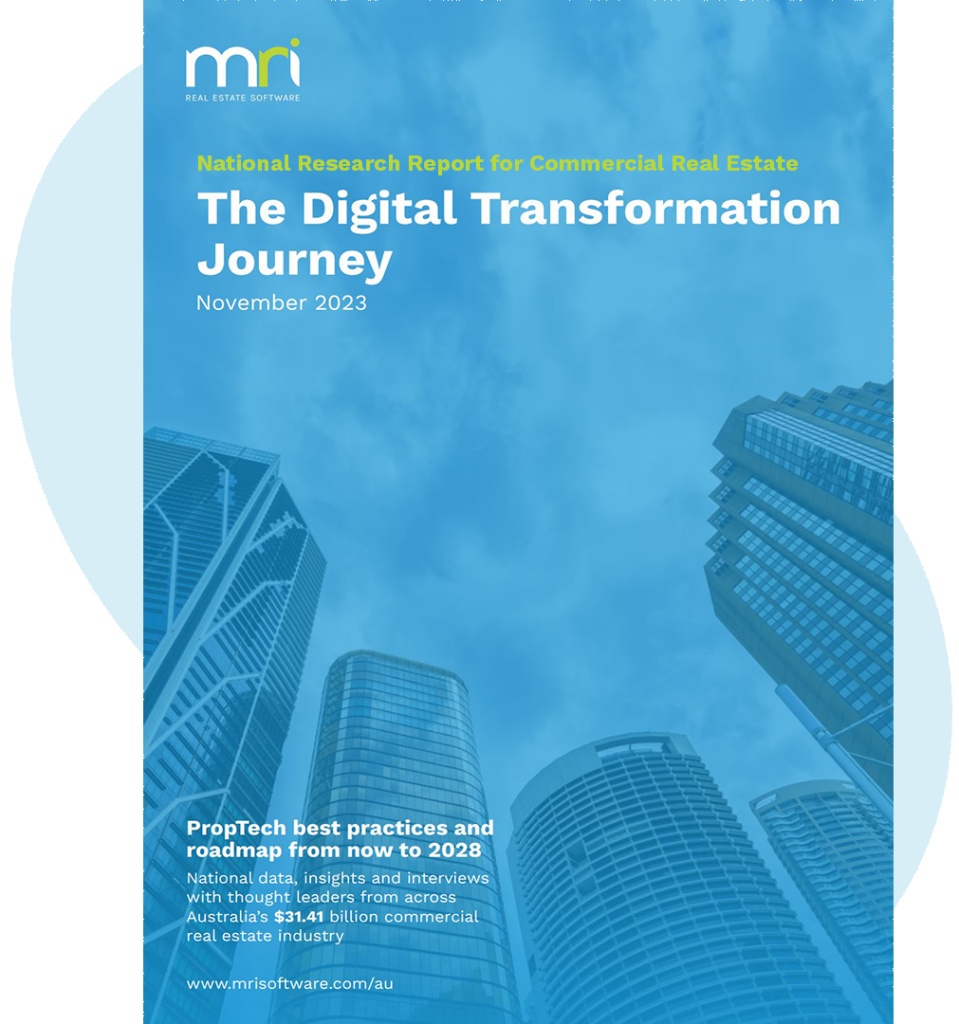Voices of Digital Transformation: Expert Insights Series
Richard Fennell, Head of Strategy and Property & Asset Management - Australia, JLL
Our expert insights series is based on outreach conducted by MRI Software for its national research report for the commercial property sector – Voices of Digital Transformation Report.
About JLL
JLL is a market-leading real estate company that manages close to 5 billion square feet of property globally. It develops, occupies and invests in properties of all types – including commercial, retail, residential, hotel and industrial assets around the world. With a reputation for innovation, JLL sees the built environment as a powerful medium that can change the world for the better.
We spoke to Richard Fennell, Head of Strategy and Property & Asset Management at JLL Australia, about how a company of JLL’s scale and complexity has successfully embraced digital transformation while maintaining a firm focus on its broader business goals.
The Digital Transformation Journey
PropTech best practices for commercial real estate from now to 2028.
Get the report
Navigating business challenges
Richard pointed out that JLL’s size and sophistication poses the biggest challenge when it comes to introducing new software systems and solutions.
“Client-centric services are really key for us,” he said. “We have over 500 clients in Australia with 1600 assets types in retail, office, industrial, residential and other areas. The key challenge we have is finding solutions that will best fit multiple outputs and ways of doing things, depending on what the client wants.”
“In short, you need to find a set of tools that are universally fit for purpose. Otherwise you’ve got a myriad of different technologies costing you lots and lots of money. Finding solutions that can be widely adopted, tailored and delivered is crucial,” he added.
Implementing new solutions
Essentially, you’re procuring a variety of solutions, forming an interconnected ‘ecosystem of systems’ that needs to evolve and operate seamlessly. To achieve this, it’s crucial to ensure easy connectivity through APIs and an open-source infrastructure.
– Richard Fennell, JLL.
According to Richard, JLL’s greatest implementation hurdle lies in the business’s complexity and diverse needs.
At JLL, dedicated teams, both locally and internationally, play a vital role in the sourcing of new technology solutions, ensuring that choices align closely with the company’s goals and objectives.
“Business technology teams working within our asset management division spend a lot of time preparing a detailed set of requirements prior to procurement,” Richard said. “Then they reach out to the market to find out what vendors can provide, what various systems are capable of, and how they can excel in meeting our needs.”
“In addition to that, we have dedicated specialists that focus on business optimisation. After we’ve gone to market, they spend time looking at how we could optimise relevant solutions once they are in place,” he added.
Managing change and measuring success
Richard believes that success comes from knowing exactly what you’re trying to accomplish from the start.
“If you’ve got a set of requirements and minimum deliverables and you stick to them, it’s clear what you’re trying to achieve. And you can measure success accordingly,” he said.
“Having a lot of scattered, iterative technology implementations, on the other hand, can result in solutions that aren’t fit for purpose, and they waste time, resources and money.”
When it comes to change management, Richard said that JLL’s approach is to engage widely with the business right from the beginning, asking for feedback on the scope of a project, and using that to set requirements.
We do a series of workshops with our team where we say, We’re considering this, how would it work? What would you need it to look like? What would you want in it?
– Richard Fennell, JLL.
“The thing about technology implementations is that they usually don’t turn out 100% as planned,” he added. “It’s important to get people’s buy-in, and allow them to participate, so that when the implementation is complete, they feel they’ve actually been part of the process.”
“It’s also an important way of keeping people in the loop about scope changes, and why you might be making adjustments during the build to allow higher-priority tasks to take the lead.”
When it comes to tracking and measurement, Richard said the business uses all the usual project management KPIs.
“We assign a project manager to each build and they apply the standard project management metrics of time, cost and variations. We also engage vendors and ask for their input on developing clear methods to track timelines, costs, and functionality,” he added.
Dealing with data security
“We have a cybersecurity team within JLL that continuously monitors our systems,” Richard explained. “Everything is backed up in data centres and we have the highest level data governance practices available to help us avoid breaches. On top of that we have very strict access control and avoid storing information in the cloud.”
Globally, we’ve seen a wave of outsourcing over the last five years, because privacy, technology and cybersecurity have all become so much more complex. For smaller organisations that manage just a handful of properties like a few shopping centres or office buildings, establishing robust cybersecurity infrastructure can be exceptionally challenging.
– Richard Fennell, JLL.
“Many are faced with the decision of either outsourcing parts of the task or opting for comprehensive outsourcing. This means not only delegating the technology aspect but also entrusting the service part to an external provider.”
According to Richard, there’s been a global shift towards a combined approach of outsourcing both service and technology, making it a more efficient and hassle-free option for many real estate businesses.
Lessons and best practices
When it comes to technology, there’s the upfront capital investment, but then there’s the support of that system down the track. And generally, the lesson we’ve learned is to ensure that you understand what support you’re going to need.
– Richard Fennell, JLL.
The post-implementation phase involves a lot of variables according to Richard. “You need to know how to upgrade a system, find ways to use it efficiently, figure out if the costs are fixed or variable based on user count and make sure it’s safe and private.”
The next big considerations are user experience and training. “If it’s really hard to access or change, those can be big roadblocks to impact and usefulness,” he suggested. “Training is also a hidden cost of any implementation – you need to train people as part of the change management process and in order to actually use the system.”
“Given JLL’s size and the level of customisation of many of our solutions, we have full time technology trainers dedicated to onboarding people into the business. It’s a benefit of scale, but if you’re a smaller organisation, it’s much harder to do,” he added.
When asked if there was one valuable piece of advice he could give Richard said it would be to avoid building a solution yourself. “Not only is that a pathway to significant expense, but it also takes a lot of time and effort,” he added. “There’s so much that’s already available – think about your ecosystem and what you want first – building it yourself probably isn’t the way to go!”
Proptech trends to watch
There’s no doubt that artificial intelligence will revolutionise the property management industry according to Richard.
“You’ve got standard AI in the form of Chat GPT, which does come with risks. Anything you add becomes publicly available, and you’re potentially leaking both clients’ confidential information and your own IP. You’ve got to be very careful about that,” he said.
He points out that JLL, like many other businesses, is finding ways around the risks AI poses by developing proprietary forms of these technologies.
At JLL, we have our own version of Chat GPT that sits on top of our database, and you can ask it questions. It automates many of our processes, and saves time and effort. The key thing is that we hold in our own environment and can control it.
– Richard Fennell, JLL.
Richard explains that report writing and data analytics have been simplified by AI. This includes things like tenant analysis, arrears and risk reporting. “It will also be useful for sustainability metrics and crunching big data sets in areas like energy and water usage across portfolios,” he added. “All of these things will be made easier through an AI lens.”
He believes that this inevitably points to a future where more and more data will be accumulated. “It’s obvious that AI’s effectiveness depends on the ability to collate and compile large amounts of data. At the end of the day, you have to collect it in order to use it.”
Download a copy of the Voices of Digital Transformation Report here and learn more about how Australian real estate businesses are embracing proptech best practices to help achieve strategic goals.
Digital Transformation and Proptech Best Practices
Like most industries, the commercial real estate sector is going through a rapid digital transformation. To better understand what specific challenges technology is now tasked with solving, we conducted an in-depth survey with over 100 leading commer…


